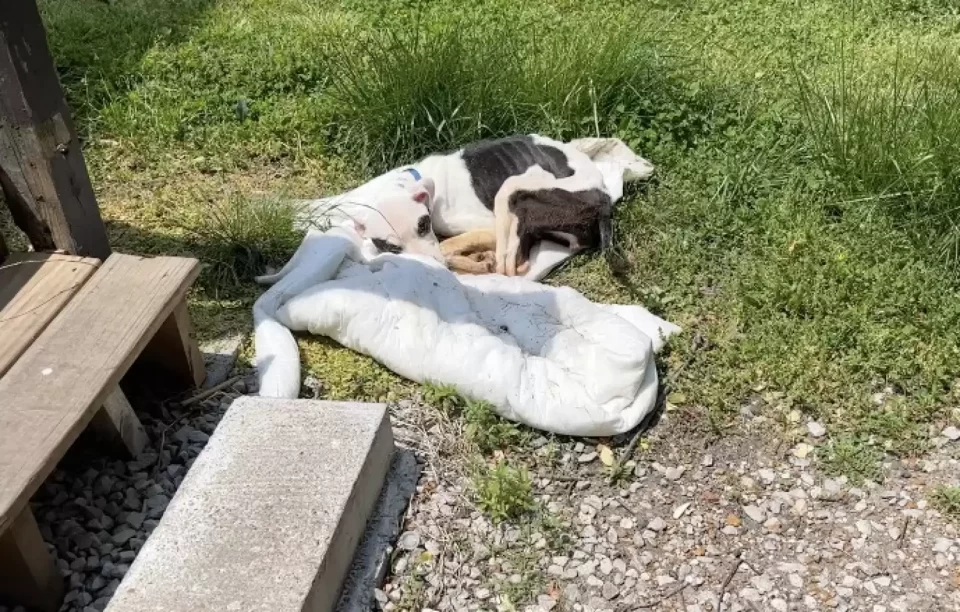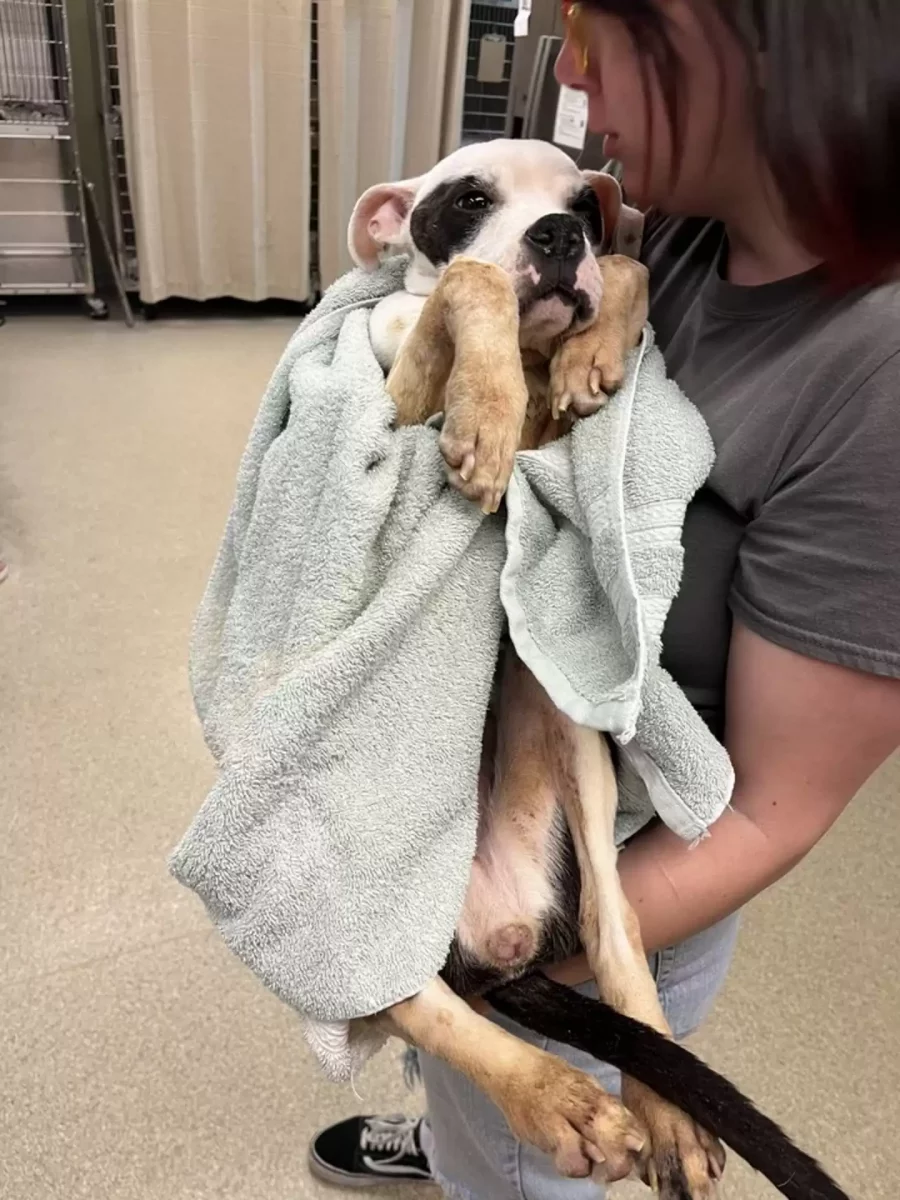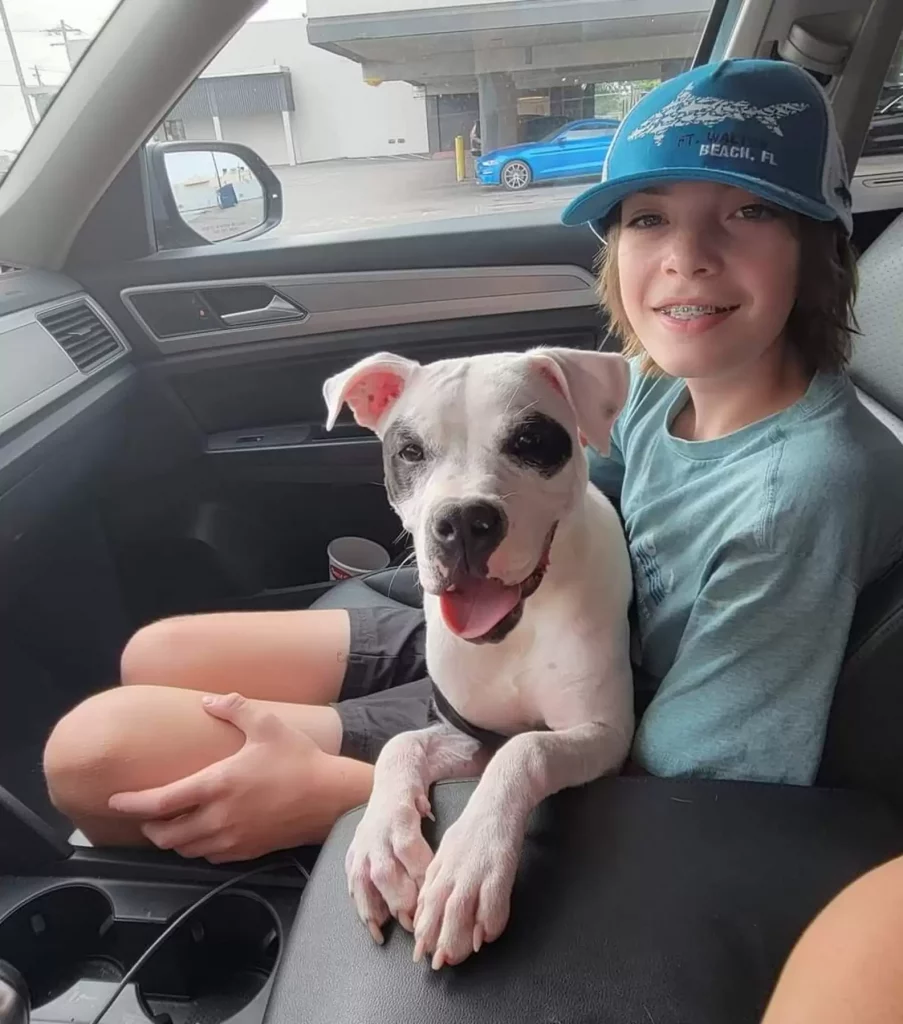One of the beautiful things about humanity is how much we can accomplish when we work together. We can solve almost anything.
One of the more prevalent problems in the world today is animal cruelty and abuse. As much as people work on it, it’s not an easy task, and there is still a lot to do, but it’s better to do it when all of our hearts are in it.
In this story, we will talk about a dog who has gone through so much but was lucky to get help from people who care and want to make the world a better place.
A Horrifying Sight

In July of this year, a man was returning home from work and noticed something strange at a bus stop nearby.
He stopped to have a better look and was appalled to realize it was actually a dog that was tied up to the bench and just left there to die.
The poor thing was so malnourished that she couldn’t even stand up.
The man called for help immediately. Donna Lochmann, Stray Rescue of St. Louis’s chief life saving officer, told The Dodo: He actually just picked her up and carried her home. Then he called us.
The woman arrived at the man’s house very quickly and was shocked by how thin the dog was.
Lochmann said: She was emaciated, not just skinny. She was outside on a little blanket, lying in the shade, but she couldn’t even stand. So, I picked her up and carried her to the Jeep.
The dog, now named She-Ra, was happy to finally get the help she needed, even though she couldn’t move.
An Inspiring Journey Of Recovery

When she finally arrived at the veterinarian clinic, they took her in immediately, did a checkup, and started her treatment.
The staff at the clinic was unsure of her background, but Lochmann suspected that she didn’t care for most of her life and spent a lot of time in a small crate.
They gave her a nice bath, and she was finally beginning to heal. Because she was so malnourished and practically starved for a long time, the staff at the clinic could not just feed her a lot of food at once.
The food was given in small doses, bit by bit, so her body could get used to processing nutrients again.
Even though she was eating pretty much regularly, she was still unable to move, so the staff decided they were going to help her move around in a stroller so she could get some fresh air.
Some time passed and she was finally able to walk again. Her body was healing at an amazing pace, and now they could even change her feeding schedule so that she could eat bigger meals.
She-Ra Finds Her Forever Home

She was taken into foster care and was finally ready for adoption. Her foster family just loved her very much.
Lochmann said: She was living in the foster home with a couple of other dogs, a cat, a monkey and a bird. She got exposed to a whole lot and was doing well. They had a huge fenced yard, and she just loved to run and play with the other dogs.
Sometime later, a family showed interest in adopting She-Ra, and they just loved everything about her. She was just so excited to meet them all, and in that moment, they just knew she was the right match for them.
In her final statement, Lochmann said: Her story has a happy ending. It’s a super happy ending for a girl who had nothing to start with. She’s just a happy dog.
It’s beautiful to see how little it takes to make a dog’s life better when all people work together to make it happen.
If you’ve ever noticed your furry friend sneaking a nibble of chocolate, you might want to think twice before letting them indulge. Chocolate, a beloved treat for many, can spell danger for our canine companions. As a seasoned dog trainer, it’s crucial to understand why this sweet delight can have fatal consequences for your four-legged buddy.
When it comes to dogs and chocolate, the combination can be a recipe for disaster. As you navigate the ins and outs of pet care, being aware of the potential risks lurking in seemingly harmless treats is key. So, let’s take a closer look at why chocolate poses a serious threat to your canine pals and how you can keep them safe from this tempting yet toxic treat.
The Toxic Relationship Between Chocolate and Dogs
Understanding Theobromine Poisoning
Theobromine, a substance in chocolate, is toxic to dogs. It affects their central nervous system and cardiovascular system. Dogs metabolize theobromine more slowly than humans, leading to toxicity at lower levels than in people. Dark chocolate contains higher theobromine levels than milk chocolate, making it more dangerous for dogs.
Factors That Influence Toxicity Levels
Several factors influence how toxic chocolate is for dogs. The type of chocolate consumed, the amount ingested, and the size of the dog play critical roles. Smaller dogs are more vulnerable to chocolate toxicity due to their size. Monitoring your dog’s access to chocolate and acting promptly if they ingest any is crucial in preventing theobromine poisoning.
By understanding the dangers of theobromine poisoning and considering the factors that impact the toxicity levels of chocolate for dogs, you can protect your furry friend from the risks associated with this sweet treat. Stay vigilant and keep chocolate out of reach to ensure the safety and well-being of your beloved pet.
How Different Types of Chocolate Affect Dogs
The Danger in Dark Chocolate
Dark chocolate poses the highest risk to dogs due to its high theobromine content. Theobromine can cause vomiting, diarrhea, rapid breathing, increased heart rate, seizures, and even death in dogs. Remember, the darker the chocolate, the more dangerous it is for your furry friend.
Milk Chocolate: Not a Safe Alternative
While milk chocolate contains less theobromine than dark chocolate, it can still be harmful to dogs, especially if consumed in large amounts. Dogs may experience symptoms like stomach upset, restlessness, and increased urination. It’s essential to keep milk chocolate out of your dog’s reach.
White Chocolate: Least Toxic But Still Harmful
White chocolate has the lowest theobromine content among chocolates, making it the least toxic option for dogs. However, it still contains fats and sugars that can lead to pancreatitis or obesity in dogs. Even though white chocolate is less dangerous, it’s best to avoid feeding it to your canine companion to prevent any potential health issues.
Recognizing Symptoms of Chocolate Poisoning in Dogs
Early Signs of Chocolate Toxicity
If your dog ingests chocolate, you may notice some early signs of chocolate toxicity. Symptoms can include vomiting, diarrhea, increased thirst, restlessness, panting, and hyperactivity. Your dog may also exhibit muscle tremors, elevated heart rate, or even seizures. These signs typically appear within 6 to 12 hours after chocolate consumption.
When to Seek Veterinary Assistance
It’s crucial to act promptly if you suspect your dog has consumed chocolate. If you observe any symptoms of chocolate poisoning or know your dog has ingested chocolate, contact your veterinarian immediately. Even if your dog seems fine initially, it’s best to seek veterinary assistance to prevent any potential complications. Treatment is more effective when started early, so don’t hesitate to get professional help.
Preventing Chocolate Poisoning in Dogs
Safe Storage of Chocolate Products
Ensure that all chocolate and cocoa products are stored in secure locations that are inaccessible to your furry friends. Remember, dogs have a keen sense of smell and can easily locate and consume chocolate if left within their reach. Store chocolate in cabinets, high shelves, or in containers that dogs cannot open to prevent accidental ingestion.
Educating Family Members About the Risks
It’s essential to educate all family members, especially children, about the dangers of chocolate for dogs. Make sure everyone understands that sharing chocolate with your canine companion is never a good idea. Encourage family members to enjoy their chocolate treats in areas where the dog cannot access them to avoid any accidental ingestion incidents. Remember, prevention is key when it comes to keeping your four-legged friend safe from chocolate poisoning.
Note: Always consult your vet for professional advice on keeping your dog safe and healthy.
Treatment Options for Chocolate Poisoning in Dogs
First-Aid Measures at Home
If your dog consumes chocolate, stay calm, and act swiftly. Immediately contact a pet poison helpline or your veterinarian for guidance. You can induce vomiting if instructed to do so, but it’s crucial to consult a professional first. Keep any packaging or remaining chocolate for identification. Do not attempt home remedies without veterinary approval as they can worsen the situation.
What to Expect at the Vet’s Office
Upon reaching the veterinary clinic, they will evaluate your dog’s condition, considering factors like the type and amount of chocolate ingested. Treatment may involve inducing vomiting, administering activated charcoal to absorb toxins, and providing supportive care such as IV fluids or medications to manage symptoms. Monitoring your dog’s vital signs and behavior is essential during treatment. Follow all post-treatment instructions carefully for your dog’s speedy recovery.
Conclusion
So, there you have it – chocolate can be a real danger to your furry friends. Remember, it’s not just about the type of chocolate, but also the amount and your dog’s size that play a role in how toxic it can be. Keep those chocolate goodies out of reach and educate everyone in your household, especially the little ones, about the risks. If you suspect your dog has indulged in some chocolate, don’t wait – contact your vet or a pet poison helpline right away. Quick action and proper treatment can make all the difference in ensuring your pup’s safety. Stay vigilant and keep those sweet treats away from your four-legged pals!
Frequently Asked Questions
Is chocolate safe for dogs to consume?
No, chocolate is toxic for dogs due to the theobromine content, which can harm their central nervous and cardiovascular systems.
What are the signs of chocolate poisoning in dogs?
Symptoms of chocolate poisoning in dogs include vomiting, diarrhea, increased thirst, restlessness, and muscle tremors.
What should you do if your dog eats chocolate?
If your dog consumes chocolate, seek immediate veterinary assistance and consider contacting a pet poison helpline or vet for guidance.
How can you prevent chocolate poisoning in dogs?
Prevent chocolate poisoning by storing chocolate securely, educating family members about the risks, keeping chocolate out of reach, and consulting a vet for advice on dog safety and health.
[no_toc]

Hey there, I’m Janet Brooks, a dog-loving student from California. I’m all about helping pups in need, especially those without homes. Me and my awesome friends work together to give shelter and love to stray dogs. Oh, and I also write blogs about dogs to share helpful info.